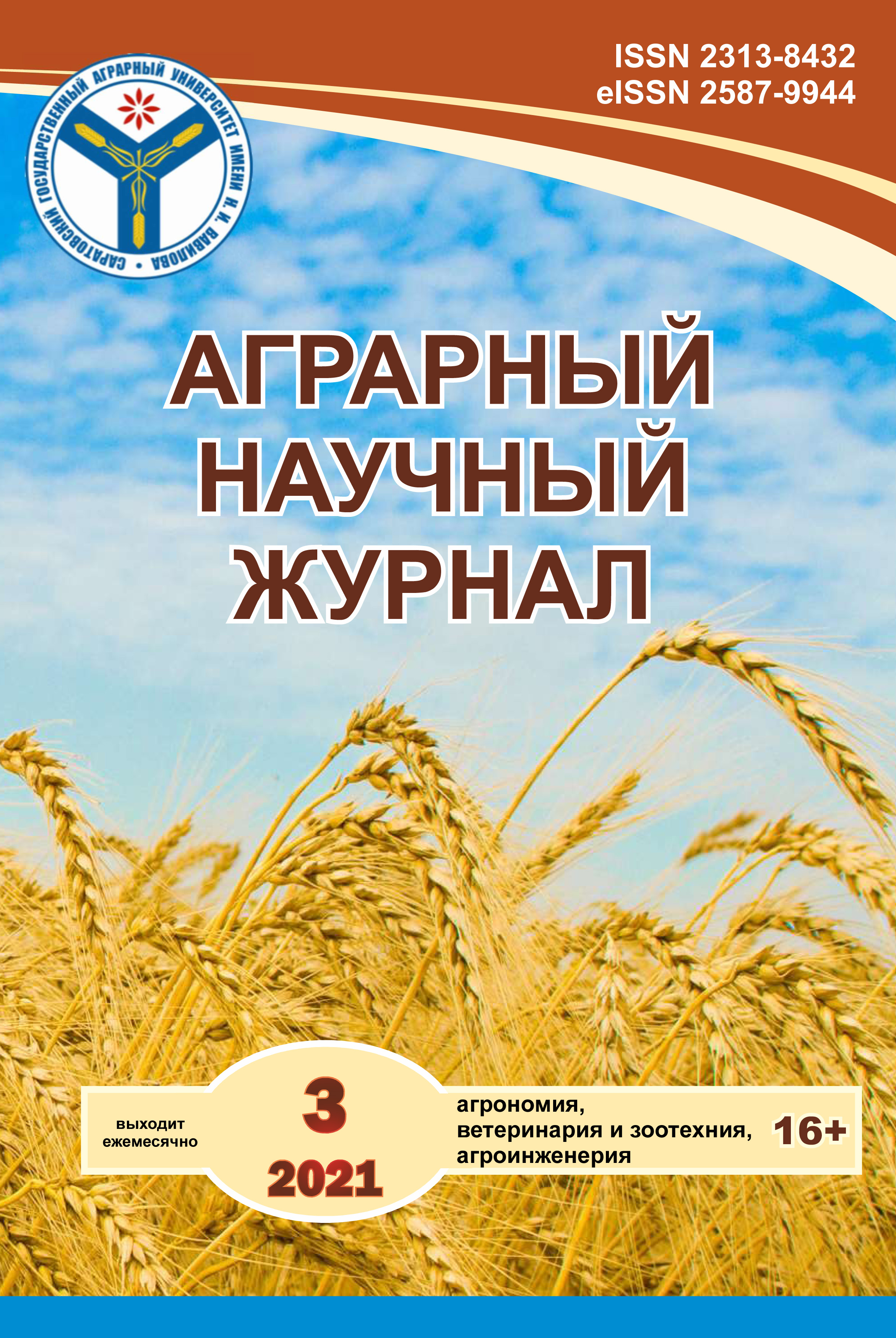Formation of productive and technological qualities of Holshtinized cattle at different levels of feeding
DOI:
https://doi.org/10.28983/asj.y2021i3pp53-57Keywords:
breed, live weight, milk productivity, fat, protein, diet, average daily gain, level of feedingAbstract
The article presents the results of growing Simmental Holstein heifers with a high heredity of 87.5% according to Holstein and the formation of their productive and technological qualities at different levels of feeding. The heifers of the control group received a food ration compiled according to detailed norms, and their counterparts from the experimental groups were 5, 10, 15, 20% higher. Heifers of the 1st experimental group in terms of live weight significantly exceed their peers from the control group: at 3 months of age by 18.3 kg, at 6 by 41.7 kg, at 9 by 55.0 kg, at 12 - tees for 69.3 kg, 15 for 80.3 kg and 18 for 74.5 kg. The advantage of the heifers of the second experimental group in the same age periods is 8.8; 24.4; 38.7; 48.9; 62.9; 56.2 kg. The heifers of the 3rd experimental group outnumbered their analogs by 5.7; 10.3; 22, 5; 27.6; 42.9; 39.2 kg, the 4th experimental group of heifers surpassed their analogues by 2.1; 4.3; 12.9; 10.4; 21.0; 21.7 kg. Animals of the first experimental group were inseminated at the age of 13.8 months, the second - 14.7 months, the third - 15.9 months, the fourth - 17.1 months, and heifers from the control group were inseminated at the age of 18.1 months. From the first heifers of the first experimental group, they drank 8909 kg of milk for the first lactation, 8549 kg for the 2nd group, 8314 kg for the 3rd, 8032 for the 4th, and 7150 kg for the control group, but the life-long milk yield was the smallest among the cows of the first group ... The more productive cows inseminated at the age of 13.8 months drop out earlier than everyone else. Therefore, for such animals it is necessary to create other conditions for feeding and keeping due to the greater intensity of their physiological functions and metabolism in general.
Downloads
References
Выращивание теленка от рождения до высокопродуктивной коровы: технологические, кормовые и ветеринарные аспекты / Л.И. Подобед [и др.]. – СПб.: РАЙТ ПРИНГТ ЮГ, 2017. – 580 с.
Гурьянов А.М., Дугушкин Н.В., Вельматов А.П. Организация выращивания высокопродуктивных коров (рекомендации). – Саранск, 2001. – 55 с.
Динамика роста, молочная продуктивность и репродуктивные качества помесного симментал ? голштинского скота / А.А. Вельматов [и др.] // Аграрный научный журнал. – 2018. – № 8. – С. 3–6.
Зборовский Л.В. Интенсивное выращивание телок. – М.: Росагропромиздат, 1991. – 238 с.
Интенсивная технология выращивания телок енисейского типа красно-пестрой молочной породы в племзаводе АО «Солгон»/ / А.И. Голубков [и др.] // Вестник КрасГАУ. – 2019. – № 8. – С.117–126.
Копанева Ю.В., Бабайлова Г.П., Ковров А.В. Влияние возраста плодотворного осеменения и живой массы на молочную продуктивность голштинизированных коров черно-пестрой породы // Аграрная наука. – 2017. –№ 10. – С. 20–23.
Матрос В.П., Конин П.А. Особенности формирования организма высокопродуктивных первотелок // Зоотехния. – 1990. – № 12. – С. 50–54.
Мороз М.Т. Кормление молодняка и высокопродуктивных коров в условиях интенсивных технологий. – СПб.: АМАНЗРФ, 2006. – 142 с.
Направленное выращивание молодняка при интенсификации скотоводства / Л.Н. Гамко [и др.]. – Брянск: Изд-во Брянской ГСХА, 2011. – 86 с.
Направленное выращивание молодняка / А.П. Курдеко [и др.]. – Горки: УО БГСХА, 2011. – 88 с.
Новое в кормлении животных: справочное пособие / под общ. ред. В.И. Фисинина [и др.]. – М.: Изд-во РГАУ – МСХА, 2012. – 788 с.
Сиротинин В.И. Выращивание молодняка в скотоводстве. – СПБ., 2007. – 210 с.
Хаблиева Р.Р. Влияние уровня кормления и раннего осеменения телок на их последующую продуктивность // Вклад молодых ученых и специалистов и научно-технический прогресс сельскохозяйственного производства. – Ставрополь, 1991. – С. 34–35.
Downloads
Published
Issue
Section
License
Copyright (c) 2021 The Agrarian Scientific Journal

This work is licensed under a Creative Commons Attribution-NonCommercial 4.0 International License.








